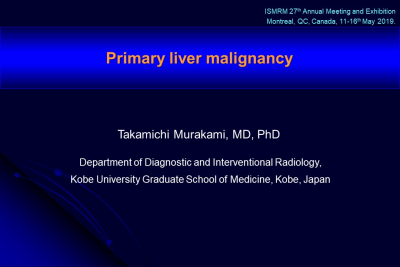Hepatobiliary
&
Imaging of Prostate Cancer
Hepatobiliary
Weekend Course
Weekend Course
ORGANIZERS: Utaroh Motosugi, Mustafa Shadi Bashir, Claude Sirlin
Saturday, 11 May 2019
| Room 518A-C | 13:30 - 15:10 | Moderators: Johannes Heverhagen, Utaroh Motosugi |
Skill Level: Basic
Session Number: WE-09A
Overview
Hepatobiliary MRI is a primary modality of detection and characterization of focal hepatic lesions, diagnosis of biliary disease, and detection and quantification of diffuse liver disease. This course will provide an overview of common hepatobiliary conditions, including both technical and clinical considerations.
Target Audience
Physicians and physicists interested in clinical liver MRI.
Educational Objectives
As a result of attending this course, participants should be able to:
- Recognize common primarily liver lesions;
- Identify key differences between benign and malignant lesions;
- Define the normal and abnormal appearance of the biliary system; and
- Choose appropriate applications for quantification of diffuse liver disease.
Overview
Hepatobiliary MRI is a primary modality of detection and characterization of focal hepatic lesions, diagnosis of biliary disease, and detection and quantification of diffuse liver disease. This course will provide an overview of common hepatobiliary conditions, including both technical and clinical considerations.
Target Audience
Physicians and physicists interested in clinical liver MRI.
Educational Objectives
As a result of attending this course, participants should be able to:
- Recognize common primarily liver lesions;
- Identify key differences between benign and malignant lesions;
- Define the normal and abnormal appearance of the biliary system; and
- Choose appropriate applications for quantification of diffuse liver disease.
| 13:30 |
Benign Primary Liver Tumors
Hero Hussain
Focal liver lesions are frequently encountered and represent a wide spectrum of pathologies. While most these lesions are benign, especially in the absence of history of malignancy and chronic liver disease, many will undergo MR imaging for characterization and reassurance. The radiologist must therefore be aware of typical and atypical imaging features of benign lesions on MR imaging, to avoid unnecessary extra tests and procedures.
|
|
| 13:55 |
 |
Malignant Primary Liver Tumors
Takamichi Murakami
Malignant primary liver tumors are classified according to their origins in the 4th WHO classification. They mostly consist of epithelial tumors such as hepatocellular carcinoma and intrahepatic cholangiocarcinoma, which are the first and second most common liver malignancies. Although each malignancy has unique imaging features on CT and MRI that lead to differential diagnosis, they are sometimes difficult to distinguish due to similarities in the backgrounds or due to combined tumors which have features of both malignancies. In this lecture, typical and atypical imaging features of those liver malignancies with reference to the current topics and considerations will be presented.
|
| 14:20 |
Biliary Disease Video Permission Withheld
Mi-Suk Park
Biliary disease: A pattern-based approach and differential diagnosis
|
|
| 14:45 |
Diffuse Liver Disease
Takeshi Yokoo
Recent advances in MRI for liver fat, iron, and fibrosis quantification has enabled “virtual liver biopsy” for patients with diffuse liver disease, and these technologies are now widely available for clinical care. The purpose of this educational session is to inform physicians and physicists of these new MRI capabilities and their potential value in clinical practice.
|
|
| 15:10 |
Break & Meet the Teachers |
Imaging of Prostate Cancer
Weekend Course
Weekend Course
ORGANIZERS: Daniel Margolis, Utaroh Motosugi
Saturday, 11 May 2019
| Room 518A-C | 15:40 - 16:55 | Moderators: Masoom Haider, Daniel Margolis |
Skill Level: Basic to Advanced
Session Number: WE-09B
Overview
Comprehensive overview of techniques for prostate cancer MRI.
Target Audience
Body radiologists and physicists.
Educational Objectives
As a result of attending this course, participants should be able to:
- Develop optimized protocol for prostate MRI depending on indication;
- Explain findings depending on indication;
- Assess value to management by contouring targets for biopsy and treatment;
- Recognize the appearance of prostate cancer before and after treatment; and
- Identify features which impact biopsy and treatment choices.
Overview
Comprehensive overview of techniques for prostate cancer MRI.
Target Audience
Body radiologists and physicists.
Educational Objectives
As a result of attending this course, participants should be able to:
- Develop optimized protocol for prostate MRI depending on indication;
- Explain findings depending on indication;
- Assess value to management by contouring targets for biopsy and treatment;
- Recognize the appearance of prostate cancer before and after treatment; and
- Identify features which impact biopsy and treatment choices.
| 15:40 |
Imaging for Biopsy Planning
Leonardo Bittencourt
In this presentation, we will discuss about imaging and clinical variables that may help achieve a better performance on MR-TRUS fusion-guided biopsies of the prostate.
|
|
| 16:05 |
Imaging for Surgery, Focal Therapy & Radiation Treatment Planning
Satoru Takahashi
Basis, characteristics and indication of potential definitive therapy for the prostate cancer; including radical prostatectomy, radiotherapy, local ablation therapy, will be demonstrated for better understanding of the appropriate management of newly diagnosed prostate cancer.
Surgical and radiological anatomy of crucial structures for preventing complications of radical prostatectomy, as well as tips, trick and pitfalls for visualizing and evaluating vital structures will be discussed. |
|
| 16:30 |
Imaging in the Post-Treatment Setting
Sadhna Verma
Learning Objectives
Describe prostate cancer treatment options (active surveillance, surgery, radiation, and focal therapies) and their imaging findings. Recognize the importance of new MRI and PET techniques in the detection of recurrence after hormone, radiation, prostatectomy and focal therapies. Understand the importance of MR imaging in surveillance after focal therapy and its role in triage and follow-up of patients who undergo active surveillance. |
|
| 16:55 |
Adjournment & Meet the Teachers |
 Back to Program-at-a-Glance |
Back to Program-at-a-Glance |  Back to Top
Back to Top